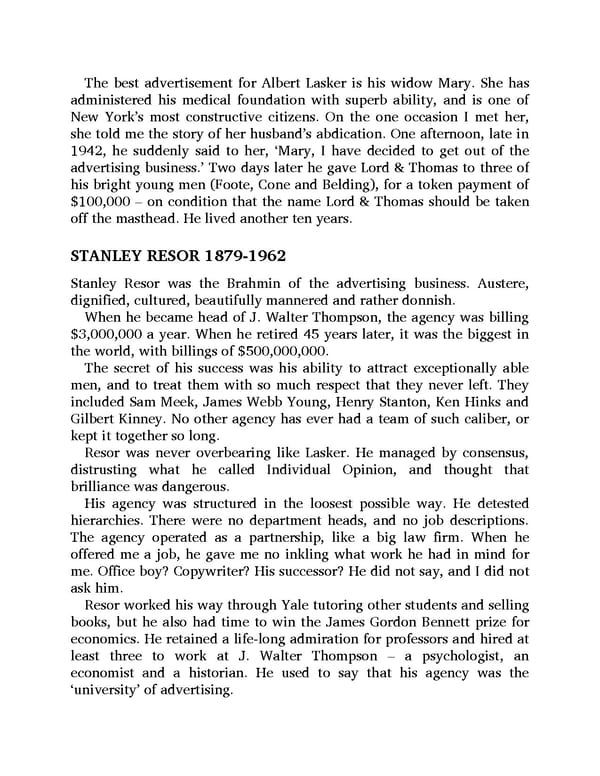The best advertisement for Albert Lasker is his widow Mary. She has administered his medical foundation with superb ability, and is one of New York’s most constructive citizens. On the one occasion I met her, she told me the story of her husband’s abdication. One afternoon, late in 1942, he suddenly said to her, ‘Mary, I have decided to get out of the advertising business.’ Two days later he gave Lord & Thomas to three of his bright young men (Foote, Cone and Belding), for a token payment of $100,000 – on condition that the name Lord & Thomas should be taken off the masthead. He lived another ten years. STANLEY RESOR 1879-1962 Stanley Resor was the Brahmin of the advertising business. Austere, dignified, cultured, beautifully mannered and rather donnish. When he became head of J. Walter Thompson, the agency was billing $3,000,000 a year. When he retired 45 years later, it was the biggest in the world, with billings of $500,000,000. The secret of his success was his ability to attract exceptionally able men, and to treat them with so much respect that they never left. They included Sam Meek, James Webb Young, Henry Stanton, Ken Hinks and Gilbert Kinney. No other agency has ever had a team of such caliber, or kept it together so long. Resor was never overbearing like Lasker. He managed by consensus, distrusting what he called Individual Opinion, and thought that brilliance was dangerous. His agency was structured in the loosest possible way. He detested hierarchies. There were no department heads, and no job descriptions. The agency operated as a partnership, like a big law firm. When he offered me a job, he gave me no inkling what work he had in mind for me. Office boy? Copywriter? His successor? He did not say, and I did not ask him. Resor worked his way through Yale tutoring other students and selling books, but he also had time to win the James Gordon Bennett prize for economics. He retained a life-long admiration for professors and hired at least three to work at J. Walter Thompson – a psychologist, an economist and a historian. He used to say that his agency was the ‘university’ of advertising.
 Ogilvy on Advertising Page 271 Page 273
Ogilvy on Advertising Page 271 Page 273